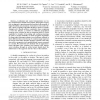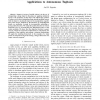105
Voted
ICRA
2008
IEEE
15 years 7 months ago
2008
IEEE
— This paper proposes a new way to achieve robotic tasks by visual servoing. Instead of using geometric features (points, straight lines, pose, homography, etc.) as it is usually...
ICRA
2008
IEEE
15 years 7 months ago
2008
IEEE
Abstract— We have recently proposed DSLX, a motion planner that significantly reduces the computational time for solving challenging kinodynamic problems by interleaving continu...
102
click to vote
ICRA
2008
IEEE
15 years 7 months ago
2008
IEEE
Abstract— We present a machine learning approach for trajectory inverse kinematics: given a trajectory in workspace, to find a feasible trajectory in angle space. The method lea...
ICRA
2008
IEEE
15 years 7 months ago
2008
IEEE
Abstract— Robust robotic manipulation and perception remains a difficult challenge, in particular in unstructured environments. To address this challenge, we propose to couple m...
118
Voted
ICRA
2008
IEEE
15 years 7 months ago
2008
IEEE
— Localization and context interpretation are two key competences for mobile robot systems. Visual place recognition, as opposed to purely geometrical models, holds promise of hi...
126
Voted
ICRA
2008
IEEE
15 years 7 months ago
2008
IEEE
Abstract— This paper describes a novel approach for incremental learning of human motion pattern primitives through on-line observation of human motion. The observed motion time ...
107
click to vote
ICRA
2008
IEEE
15 years 7 months ago
2008
IEEE
— Assume a swarm of mobile robots is in the act of transporting a large object in the plane, by applying unilateral forces to the perimeter of that object. We address the questio...
ICRA
2008
IEEE
15 years 7 months ago
2008
IEEE
— Coordination of a group of mobile robots is facilitated when they are able to determine their positions relative to each other. Instead of using an absolute positioning approac...
ICRA
2008
IEEE
15 years 7 months ago
2008
IEEE
— We examine the usefulness of passive compliance in a manipulator that learns contact motion. Based on the notice that humans outperforms robots with the contact motion, we foll...
93
Voted
ICRA
2008
IEEE
15 years 7 months ago
2008
IEEE
Abstract— We propose a new approximate algorithm, LAJIV (Lookahead J-MDP Information Value), to solve Oracular Partially Observable Markov Decision Problems (OPOMDPs), a special ...





